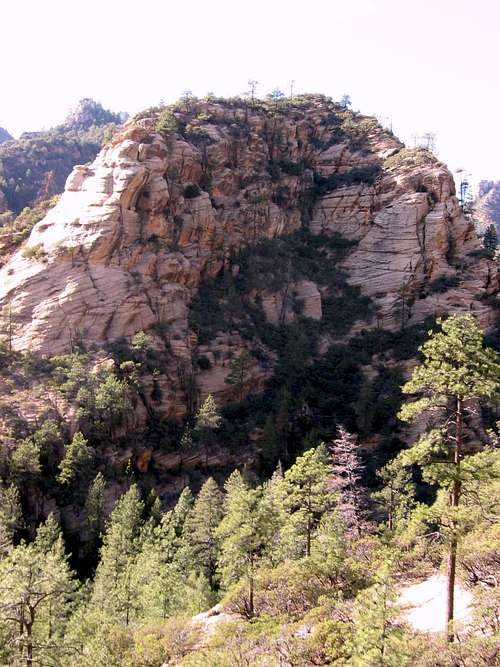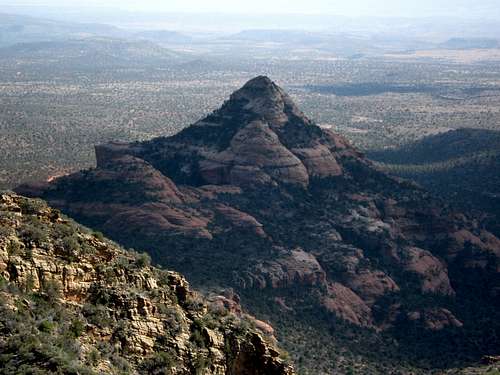-
 10582 Hits
10582 Hits
-
 79.78% Score
79.78% Score
-
 11 Votes
11 Votes
|
|
List |
|---|---|
|
|
Sedona Summits
Sedona, Arizona - the name brings many things to mind. Surreal landscapes. Vortices and New Age folks selling crystals. Redrock and incredible colors. The classic view of Cathedral Rock from Oak Creek. Sinagua ruins. Tourists taking $100 jeep tours to places they could hike in an hour. Huge buttes, towers, walls, and spires. Incredible sandstone formations like Snoopy, the Cow Pies, B.J. Rock, Courthouse Butte, Bell Rock, and Queen Victoria.As a mildly surprising sequel to the highest ten Sedona summits, I present to you…
Sedona Summits 31-40!
From redrock fin to forested butte, from the back canyons to the Mitten Ridge, these summits are as varied in character and location as the higher Sedona peaks. And at only slightly over a mile in elevation, one might think that the decrease in height would make them easier to reach. But it is not so. Sedona summits 31 to 40 show no lessening in difficultly from the three groups preceding them. In fact, they may very well be harder to attain than the higher peaks. Not a single one of these has a trail to the top, and five of them require technical climbing… on what is most likely the easiest route. I’ve already said it, but let me reiterate: Although they present adventures, I would hesitate to recommend any of these summits to other hikers and climbers. The dangers are very high, and the potential for serious injury or death is great. So put down the rope and rack, head up the road to Flagstaff, and have a nice hike to Humphreys, Kendrick, Elden, or the Beaver Street Brewery. Do not climb in Sedona. There. I’ve said my piece. Here, then are the summits.
Sedona Summits 31-40
UN 5873 – “Lost Lee Mountain” – is a subsidiary summit on Lee Mountain’s massive west ridge. Routefinding is a challenge here, although the way is not overly technical if you can find it. From the summit, unobstructed views south of Sedona can be found… from Cathedral Rock to Courthouse Butte to Oak Creek Spire.
UN 5860, “Dry Creek Butte,” is far in the northern backcountry at the end of its namesake canyon. Though the climb is a short one, it involves cheery Sedona mixed climbing: loose rock and thick underbrush at a high angle. Scaling Dry Creek Butte can be tough; actually finding it can present a significant challenge as well.
The slender summit ridge of UN 5848 forms part of the high wall between Long and Boynton canyons… and is difficult to access from either one. Like many buttes of this elevation, the lower slopes of UN 5848 are covered with overhanging sandstone walls, and breaks in this defense are few and far between. Don’t always count on rappelling; in many places a single rope won’t reach.
UN 5838 stands alone above Oak Creek Canyon, in the shadow of massive Wilson Mountain. It is not an overly high or impressive objective, but the fires which roared through this area loosened the butte’s slopes enough to make them dangerous. And the small summit offers great views of the canyon, Wilson itself, and Bad Rock Peak, looming to the north.
Guarding the northwestern edge of Sedona like a sentinel, Loy Butte towers above the canyon which bears its name. As on many Sedona summits, taking the easiest route keeps it to 3rd or 4th class – but go the wrong way and you’ll never make it. Look carefully and you might find some remains of cliff dwellings, and other ruins which dot Loy’s slopes.
UN 5667, "The Fin," is a sail-shaped formation just south of Wilson Mountain. From many angles it looks like a large, square butte with a sheer south face, but those who’ve hiked around it can attest that the façade is misleading. UN 5667’s summit ridge is frighteningly thin – only several feet wide – and the easiest route is an exposed, two-pitch 5.7.
A complex mass of red spires, towers, and other formations, UN 5660 lies between Secret and Bear Sign canyons. Another archetypical Sedona mixed climb, its summit is surrounded by frustrating snarls of thick vegetation and difficult rock. My advice: bring a tweezers to pick the cactus spines out of you after the descent.
Teapot Rock is one of four summits along the ridge north of Bear Wallow Canyon. From 89A the likeness is hard to miss: the spout is a lower summit to the west and the main summit, the teapot itself. Don’t let the cute name fool you – Teapot is one of the harder summits in Sedona and the easiest route goes at 5.9 or so.
UN 5634 – “Ruin Butte” – sits near the mouth of Boynton Canyon. Although the vertical distance to the summit is not great, sheer and overhanging walls protect this butte on all sides. There is only one good way up, and that requires a few exposed 5th class moves and some cojones as well. Keep your eyes open for Sinagua ruins on the way.
UN 5598 also lies in Boynton, a mile or so back along the southwest wall of the canyon. Sandstone overhangs prevent almost all access to the tiny summit, and only by zig-zags and traverses can you avoid them. Though not so intimidating in sheer height, UN 5598 is far more difficult than many summits here which are hundreds of feet higher.
Table: Summits 31 - 40
| Rank | Peak | Elevation | 7.5 minute Quadrangle |
| 31 | UN 5873 “Lost Lee Mtn.” | 5,873 | Munds Mountain |
| 32 | UN 5860 “Dry Creek Butte” | 5,860 | Wilson Mountain |
| 33 | UN 5848 | 5,848 | Wilson Mountain |
| 34 | UN 5838 | 5,838 | Munds Park |
| 35 | Loy Butte | 5,700 | Loy Butte |
| 36 | UN 5667 "The Fin" | 5,667 | Wilson Mountain |
| 37 | UN 5660 | 5,660 | Wilson Mountain |
| 38 | UN 5652 "Teapot Rock" | 5,652 | Munds Mountain |
| 39 | UN 5634 "Ruin Butte" | 5,634 | Wilson Mountain |
| 40 | UN 5598 | 5,598 | Wilson Mountain |













